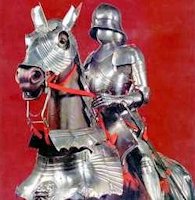
|
Some Common Myths Thought to be True - Myth 5
Myth 5: Plate Armor in Middle Ages Hindered Moving Around
The plate armour of European soldiers did not stop soldiers from moving
around or necessitate a crane to get them into a saddle. They would as a matter
of course fight on foot and could mount and dismount without help. In fact
soldiers equipped with plate armour were more mobile than those with mail
armour (chain armour), as mail was heavier and required stiff padding beneath
due to its pliable nature. It is true that armour used in tournaments in the
late Middle Ages was significantly heavier than that used in warfare, which may
well have contributed to this misconception.
|
| Plate Armor | |
|
While there are early predecessors such as the Roman-era lorica segmentata,
full plate armour developed in Europe during the Late Middle Ages, especially
in the context of the Hundred Years' War, from the coat of plates worn over
mail suits during the 13th century. In Europe plate armour reached its peak in
the late 15th and 16th centuries, and the full suit of armour, commonly
perceived as "medieval", was actually only a feature of the very end of the
Middle Ages and of the Renaissance period. Full suits of Gothic plate armour
were worn on the battlefields of the Burgundian and Italian Wars.
|
|
| ⇦ Back to Myth 4 Return to Myth Choices Page 1 On to Myth 6 ⇨ | |